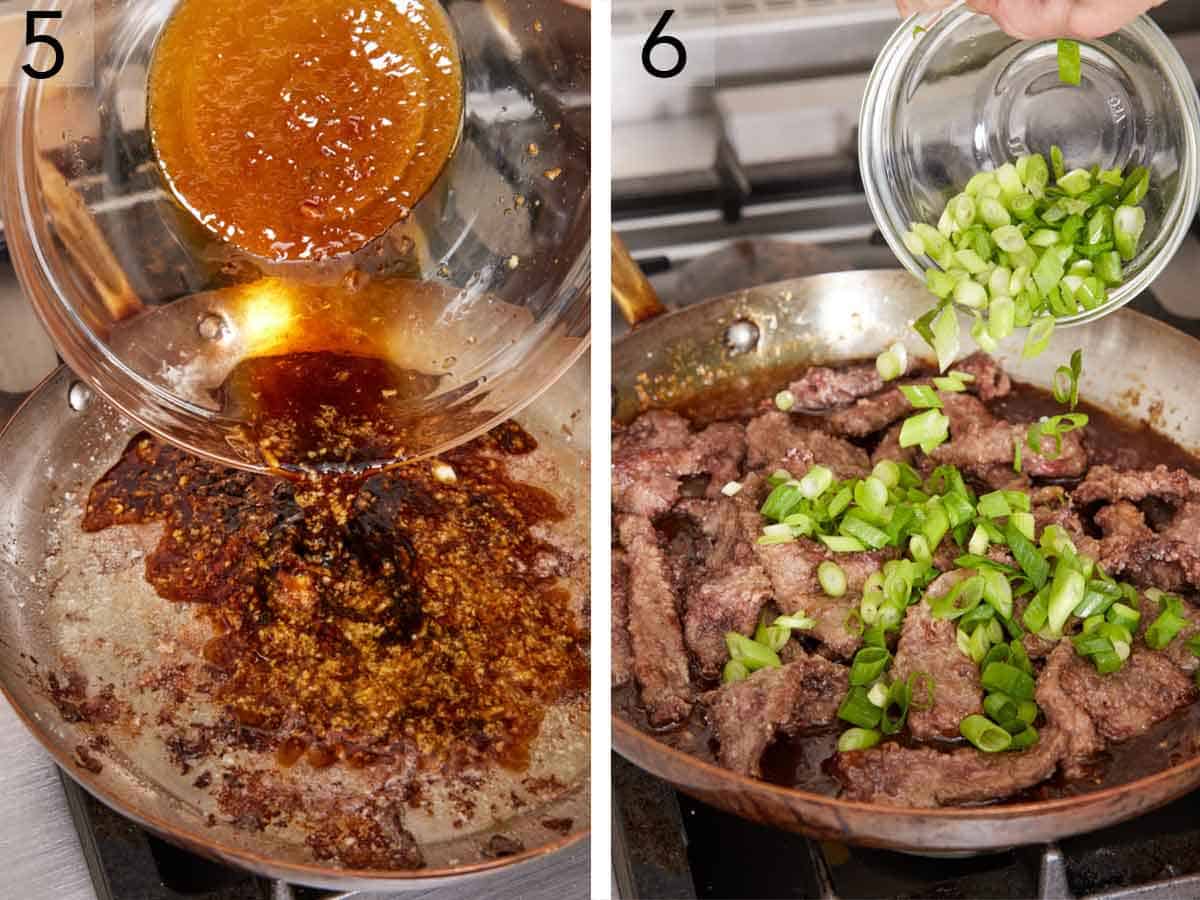This easy Mongolian Beef recipe is tender, saucy, and ready in a snap. Made by quickly cooking sliced flank steak and then simmering it in a sticky sauce, you can make this dish in about 15 minutes! It’s ideal for busy weeknights when you are craving a comforting meal.
My favorite way to serve this recipe is over steamed rice with a side of broccoli. The rice soaks up some of the homemade Mongolian beef sauce and helps balance the heat of the peppers if you choose the spicy version of this recipe. For more stir-fry recipes, try my kung pao chicken, moo goo gai pan, and vegetable stir fry.
What Is Mongolian Beef?
Mongolian Beef is a Chinese-Taiwanese dish that was actually created and served in popular Mongolian barbecue restaurants throughout Taiwan. Thin slices of steak are stir-fried and coated with a sticky sauce, and tossed with green onions and dried chilis. Since its introduction to the US, it has become a popular staple on Chinese restaurant menus, served over steamed rice or glass noodles.
Ingredients

Soy sauce – soy sauce adds a salty, savory flavor to the sauce. You can use a low sodium soy sauce if preferred.
Brown sugar – light brown sugar adds just the right amount of sweetness to the savory sauce and makes it sticky.
Flank steak – look for a steak that has red coloring (not grey) and appears moist but not wet. If you don’t see flank steak in the meat case, you can typically ask the butcher to cut one for you.
Cornstarch – coating the steak strips in cornstarch helps the meat to get crispy on the outside and forms a crust for the sauce to cling to so it coats the meat well.
Vegetable oil – this oil is great for searing and cooking steak because it helps it to brown well and can handle high heat.
Red chilies – dried red chili peppers are typically found in the spice aisle or international food section of most grocery stores. Look for dried Chinese red chilies, or use chile de arbol. If you don’t have whole dried chilies, you can substitute ½ teaspoon of red pepper flakes.
How To Make Mongolian Beef

1. In a medium bowl, combine the soy sauce and water.
2. Whisk in the brown sugar, fresh ginger, and garlic. Set the sauce aside.

3. Slice the steak into ¼ inch pieces using a sharp knife and add it to a large bowl. Add the cornstarch and toss together until the steak is well coated.
4. Heat the vegetable oil in a large skillet or wok over medium-high heat. Using your hands or tongs, shake any excess cornstarch off of the beef strips before adding them to the skillet. Cook, stirring occasionally, until browned and mostly cooked through, about 3-4 minutes. Use tongs to transfer the hot steak to a bowl.

5. Maintain a medium-high heat and add the sauce to the pan. Scrape any browned bits from the bottom of the skillet as you stir the sauce. Cook for about 3 minutes or until the sauce has thickened.
6. Add the cooked beef, red chilies (if using), and green onions to the sauce. Cook, stirring often, for about 1 minute until the sauce has coated the beef and the onions are softened. Serve immediately with rice.

Tips for Cutting the Beef
Freeze the beef so it is easier to slice: Put the flank steak in the freezer for 5 to 10 minutes before slicing. Freezing the flank steak firms up the outside so the meat has less give when you press your knife into it.
Cut the steak against the grain: For the most tender slices, you want to cut against the grain instead of with it. Look for the direction of the muscle fibers in the steak and make your cuts by running your knife perpendicular to (or across) them. Use a sharp knife and slice it into pieces that are about ¼ inch thick.
What to Serve with Mongolian Beef
Serve this recipe for Mongolian beef with white rice, instant pot brown rice, or fried rice, and your favorite roasted or stir-fried vegetables. You can garnish the beef with additional green onions, red pepper flakes, or sesame seeds.

Pro Tips For Making This Recipe
- Sear the meat before stirring. Add the meat to the skillet with the hot oil in a single layer. Allow it to cook until it is deeply browned and seared on the first side before stirring it. You will know the meat is properly seared when it easily releases from the pan when stirred. If you try to stir the meat too soon, it will stick.
- Cook in batches, if needed. You don’t want to overcrowd the pan when searing the beef; otherwise, it will steam and not brown. If you can’t fit all of the sliced beef in the skillet at first without them overlapping, cook them in batches, adding extra oil as needed.
- Mix in or serve with additional vegetables. To add in vegetables, serve this dish with or mix in steamed broccoli, snow peas, sliced bell pepper, or carrots.

Frequently Asked Questions
There are a few good substitutions for flank steak in this recipe. Skirt steak, commonly used in fajitas, will slice nicely into strips. You can also use a flat iron steak, hanger steak, or sirloin steak.
This recipe is easy to adapt to cook in a slow cooker instead of the stovetop. This is a great option if you need to prepare the ingredients a few hours before eating. To make this in the crock pot, mix the sauce ingredients and set aside. Slice the beef and toss with the cornstarch. Add the beef to the slow cooker and pour the sauce on top. Cook on low for 4-5 hours or high for 2-3 hours or until the sauce has thickened and the meat is cooked through.
Keep in mind that because you aren’t searing the beef, the flavor will be a bit less robust, and the meat will not be crispy.
Leftovers should be refrigerated in an airtight container for up to 3 days. If you expect to have leftovers, keep the steak separate from the rice or vegetables you may serve with this recipe to make reheating easier.
Reheat the steak in a skillet over medium heat until the sauce simmers and the steak is warmed through. Add a small amount of water to the pan while reheating if the sauce has become too thick.
If you’ve tried this Mongolian Beef recipe, then don’t forget to rate it and let me know how you got on in the comments below. I love hearing from you!

Mongolian Beef Recipe
Equipment
- Mixing Bowls
- Large skillet or wok
Ingredients
For the Sauce
- ⅓ cup soy sauce (80ml)
- ⅓ cup water (80ml)
- ⅓ cup light brown sugar (73g)
- 1 ½ tablespoons minced ginger
- 6 garlic cloves minced
For the Beef
- 1 pound flank steak thinly sliced against the grain (450g)
- ⅓ cup cornstarch (37g)
- 3 tablespoons vegetable oil
- 10 dried red chilies (or ½ teaspoon crushed red pepper flakes), optional
- 5 green onions sliced into 1-inch pieces (2¾oucnes/80g)
Instructions
For the Sauce:
- In a medium bowl, whisk together the soy sauce, water, brown sugar, ginger, and garlic. Set aside.
For the Beef:
- In a large bowl, toss the steak with the cornstarch until well coated.
- In a large skillet or wok, heat the oil over medium-high heat. Shake the beef strips to remove excess cornstarch, and then add the beef to the skillet. Cook, stirring occasionally, until the beef is browned and mostly cooked through, 3 to 4 minutes. Transfer the beef to a large bowl.
- With the skillet still over medium-high heat, add the sauce to the skillet and cook, stirring occasionally, scraping any browned bits from the bottom of the skillet with a spoon, until the sauce is thickened, about 3 minutes. Stir in the beef, red chilies (if using), and green onions.
- Cook, stirring often, until the beef is well coated and the green onions are softened, about 1 minute. Serve immediately over rice.
Notes
- Sear the meat before stirring. Add the meat to the skillet with the hot oil in a single layer. Allow it to cook until it is deeply browned and seared on the first side before stirring it. You will know the meat is properly seared when it easily releases from the pan when stirred. If you try to stir the meat too soon, it will stick.
- Cook in batches, if needed. You don’t want to overcrowd the pan when searing the beef; otherwise, it will steam and not brown. If you can’t fit all of the sliced beef in the skillet at first without them overlapping, cook them in batches, adding extra oil as needed.
- Mix in or serve with additional vegetables. To add in vegetables, serve this dish with or mix in steamed broccoli, snow peas, sliced bell pepper, or carrots.















Leave a Reply